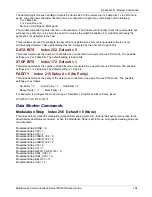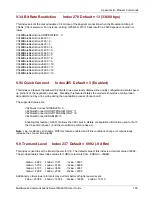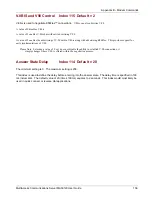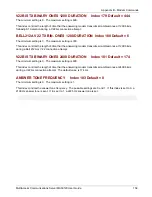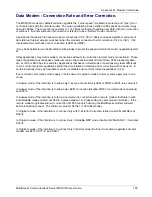
Glossary
MultiAccess Communications Server MA30120 User Guide 168
particular HTML element once, and then use it over and over on any number of Web pages. To change how an
element looks, you just change the style; the element automatically changes wherever it appears. (Before CSS,
you had to change the element individually, each time it appeared.) Style sheets let Web designers more
quickly create consistent pages and more consistent web sites.
Browsers began supporting the first CSS Specification, Cascading Style Sheets, Level 1 (CSS1), in versions
3.0 of Opera and Microsoft Internet Explorer and in version 4.0 of Netscape Navigator. The 4.0 and later
versions of all three browsers also support properties from the newer Cascading Style Sheets, Level 2 (CSS2)
specification, which let you specify elements' visibilities, their precise positions on the page, and how they
overlap each other.
Certificate
– A cryptographically signed object that contains an identity and a public key associated with the
identity. Public key certificates are digital stamps of approval for electronic security. The three main
characteristics of certificates are: 1) provide identification of the web site and the owner, 2) contain the public
key to be used to encrypt and decrypt messages between parties, and 3) provide a digital signature from the
trusted organization that issued the certificate, as well as when the certificate expires.
Certificate Authority
– The issuer of a certificate is the Certificate Authority (CA). The CA is the party that
digitally signs a certificate and ensures its validity. There are two types of CAs, private and public. Private CAs
issue certificates for use in private networks where they can validate the certificate. Public CAs issues
certificates for servers that belong to the general public. A Public CA must meet certain requirements before
they are added as a root authority to a browser. Since this is a controlled process, all public CA must be
registered to issue certificates.
Certificate Revocation List
–
A log of certificates that have been revoked before their expiration date.
Cipher
–
An encryption/decryption algorithm.
Ciphertext
–
Encrypted data.
Client-Server Model
–
A common way to describe the paradigm of many network protocols. Examples include
the name-server/name-resolver relationship in DNS and the file-server/file-client relationship in NFS.
CHAP (Challenge Handshake Authentication Protocol)
– An IETF standard for authentication using PPP
which uses a "random Challenge", with a cryptographically hashed "Response" which depends on the
Challenge and a secret key.
Client
– A client is a program that communicates with a server via a network, so as to use the service provided
by that server. Example: Netscape is a www client, with the help of which one can call up information from a
www server.
Client-Server Principle
– Applications based on the client-server principle use a client program (client) at the
user-end that exchanges information with a server on the network. Usually the server is responsible for the data
keeping, while the client takes over the presentation of this information and the interaction with the user. For
this, the server and the client employ an exactly defined protocol. All the important applications in the Internet
(e.g. www, FTP, news) are based on the client-server principle.
CMP (Certificate Management Protocol)
– A protocol defining the online interactions between the end entities
and the certification authority in PKI. It is written by PKIX working group of IETF and is specified in document
RFC 2510.
Compromise
–
The unintended disclosure or discovery of a cryptographic key or secret.
CRL
–
Certificate Revocation List.
Cryptography
–
The art and science of using mathematics to secure information and create a high degree of
trust in the networking realm. See also public key, secret key.
CSR (Certificate Signing Request)
– The form used to obtain a certificate from a CA. A CSR generates a
formatted certification. This request is located on the web site of all certificate authorities. Another way to
generate a CSR is to use a utility such as Microsoft IIS or OpenSSL.
Datagram
– The unit of transmission at the ISO Network layer (such as IP). A datagram may be encapsulated
in one or more packets passed to the data link layer. A datagram is a self-contained, independent entity of data
carrying sufficient information to be routed from the source to the destination computer without reliance on
earlier exchanges between this source and destination computer and the transporting network.
Summary of Contents for MultiAccess MULTIACCESS MA30120
Page 1: ...MA30120 User Guide ...

